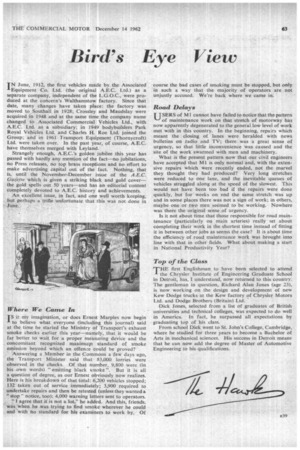Bird's Eye View
Page 65

If you've noticed an error in this article please click here to report it so we can fix it.
TN June, 1912, the first vehicles made by the Associated -I-Equipment Co. Ltd. (the original A.E.C. Ltd.) as a separate company, independent of the L.G.O.C., were produced at the concern's Waltharnstow factory. Since that date, many changes have taken place: the factory was moved to .Southall in 1928; Crossley and Maudslay were acquired in 1948 and at the same time the company name changed to . Associated Commercial Vehicles Ltd., with A.E.C. Ltd. as a subsidiary; in 1949 bodybuilders Park Royal Vehicles Ltd. and Charles H. Roe Ltd. joined the Group; and in 1961 Transport Equipment (Thornyeroft) Ltd. were taken over. In the past year, of course, A.E.C. have themselves merged with Leyland.
Strangely enough, A.E.C. 's golden jubilee this year has passed with hardly any mention of the fact—no jubilations, no Press releases, no top brass receptions and no effort to make advertising capital out of the fact. Nothing, that is, until the November-December issue of the A.E.C. Gaieve which is given a striking black and gold cover— the gold spells out 50 years—and has an editorial content completely devoted to A.E.C. history and achievements.
An excellent issue, in -fact, and one well worth keeping; but, perhaps a trifle unfortunate that this was not done in
1here We Caine In
IS it my imagination, or does Ernest Marples now begin to believe what everyone (including this journal) said at the time he started the Ministry of Transport's exhaust smoke checks earlier this year—namely, that it would be far better to wait for a proper measuring device and the concomitant recognized maximmir standard of smoke emission beyond which an offence could be proved?
Answering a Member in the Commons a few days ago, the Transport Minister said that 83,000 lorries were observed in the checks. Of that number, 9,800 were (in his own words) "emitting black smoke ". But it is all a question of degree, as our Ernest obviously now realizes. Here is his breakdown of that total: 6,200 vehicles stopped; 132 taken out of service immediately; 3,900 required to undertake repairs and then be retested (unless they wanted a "stop" notice, too); 4,000 warning letters' sent to operators.
"I agree that it is not a lot," he added. And this, friends, was when he was trying to find smoke wherever he could and with no standard for his examiners to work by. Of course the bad cases of smoking must be stopped, but only in such a way that the majority of operators are not unjustly accused. We're back where we came in.
Road Delays
SERS of M1 cannot have failed to notice that the pattern
of maintenance work on that stretch of motorway has now apparently degenerated to the general low level of work met with in this country. In the beginning, repairs which meant the closing of lanes were heralded with news bulletins on radio and TV; there was a great sense of urgency, so that little inconvenience was caused and the site of the work swarmed with men and machinery.
What is the present pattern now that our civil engineers have accepted that M1 is only normal and, with the extensive repairs which were recently ended, not the marvel they thought they had produced? Very long stretches were reduced to one lane, and the inevitable queues of vehicles struggled along at the speed of the slowest. This would not have been too bad if the repairs were done quickly, but for • weeks on end the same stretch was up and in some places there was not a sign of work; in others, maybe one or two men .seemed to be working. Nowhere was there the original sense of urgency.
Is it not about time that those responsible for road maintenance (particularly on main arteries) really set about completing their work in the shortest time instead of fitting it in between other jobs as seems the case? It is about time the efficiency of road maintenance work was brought into line with that in other fields. What about making a start in National Productivity Year?
Top of the Class
THE first Englishman to have been selected to attend the Chrysler Institute of Engineering Graduate School in Detroit, has, I understand, now returned to this country. The gentleman in question, Richard Alan Jones (age 23), is now working on the design and development of new Kew Dodge trucks at the Kew factory of Chrysler Motors Ltd. and Dodge Brothers (Britain) Ltd.
Dick Jones, selected from a list of graduates of British universities and technical colleges, was expected to do well in America. In fact, he surpassed all expectations by graduating top of his class.
From school Dick went to St. John's College, Cambridge, where he studied for three years to become a Bachelor of Arts in mechanical sciences. His success in Detroit means that he can now add the degree of Master of Automotive Engineering to his qualifications.




















































































































